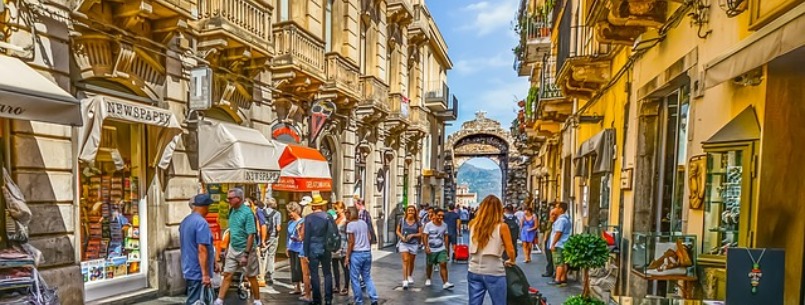Sicilian People
Sicilians might look intimidating and distant at times, but they open up pretty quickly. They are resourceful and among the most generous people, I know. They might not fully understand you while you order your meal in English or ask for directions, but whatever they answer or mimic to you will be perfect anyway.
On the sixth day, God accomplished His work and, pleased with all the beauty He had created, He took the Earth in His hands, and kissed it. There, where He put His lips,that’s Sicily.
Sicilian Beaches
It is summer and it is going to be how. No question about it. So, get ready to head to the beach to cool off. Sicily has an impressive array of beaches: sandy, rocky remote… San Vito Lo Capo is always ranked among the best Italian beaches.
San Vito Lo Capo in the province of Trapani wins TripAdvisor’s “Travelers’ Choice Beaches Award” as best Italian Beach. The selection is based on millions of reviews and opinions posted by travelers from all over the world. This beautiful town in Northwestern Sicily is famous for the crystal-blue water of the Mediterranean Sea and the 2-mile long fine golden sand beach. The weather is best in the summer months, but San Vito Lo Capo has much more to offer all-year-round. Every September the town hosts the “Cous Cous Fest”, an international festival of culture and gastronomy of the Mediterranean.
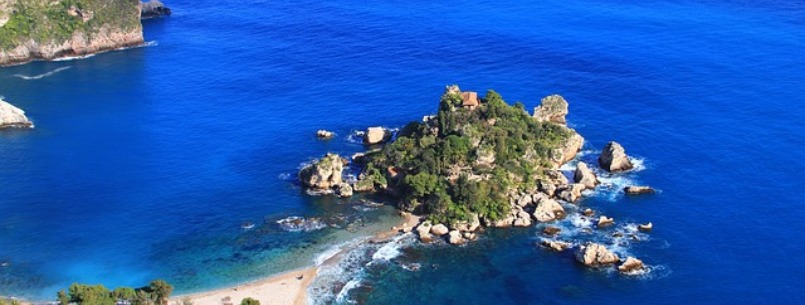
Minor Islands of Sicily
If you have already been to Sicily several times and you ready to explore more. Think about going to one of the minor islands that can be easily reached by boat.
The Aeolian Islands (Italian: Isole Eolie) are a volcanic archipelago in the Tyrrhenian Sea north of Sicily. They are a popular tourist destination in the summer and attract up to 200,000 visitors annually. The largest island is Lipari, and tourism marketing often names the entire archipelago the Lipari Islands because of the ease of pronouncing Lipari compared to Aeolian. The other islands include Vulcano, Salina, Stromboli, Filicudi, Alicudi, and Panarea. The town of Lipari has about 11,000 inhabitants. Vulcano is famous for its fango baths.
Highlights: Aeolian Archeological Museum; Calajunco (Pantelleria).
Pantelleria is entirely of volcanic origin and about 45 mi² (117 km²) in the area. Hot mineral springs and ebullition of steam still testify to the presence of volcanic activity. The island is fertile but lacks fresh water. The principal town (pop. about 3,000) is in the northwest, around the only harbor (only fit for small steamers). The zibibbo grapes and a strong, fragrant spiced wine are produced from its vineyards. The gastronomy offers dishes such as bitter ravioli stuffed with ricotta cheese and mint, stuffed eggplants, fish couscous, capers, and very small and tasty lentils.
Highlights: There are many grottos where it is possible to take healthy steam baths; one of the most famous being the ‘Stufa’ (stove) del Bagno di Arturo near Sibà; the beach Balata dei Turchi.
Ustica is the name of a small island, about 6 miles across (9 km), situated 33 miles (52 km) north of Capo Gallo, Italy. Roughly 1400 people live there. Its fate in modern times has always been that of being a prison and place of exile until the end of the Second World War. Nowadays, Ustica has recovered its priceless natural resources thanks to the Marine Reserve. Its gastronomy includes all the typical Sicilian dishes such as pasta with sardines, the famous caponata (selection of vegetables and other ingredients fried together), spaghetti with lobster and many other delicacies.
Highlights: Capo Falconiera; scuba diving.
The Aegadian Islands (Italian: Isole Egadi), are a group of small mountainous islands in the Mediterranean Sea off the northwest coast of Sicily, Italy, near the city of Trapani, with a total area of 22,97 mi² (37,45 km²). Favignana (Aegusa), the largest, lies 10 miles southwest of Trapani; Levanzo (Phorbantia) 8 miles west; while Marettimo, the ancient Iera Nesos, 15 miles west of Trapani, is now reckoned as a part of the group. There are also some minor islands between Favignana and Sicily. The overall population in 1987 was estimated at about 5,000. The main occupation of the islanders is fishing and this is where the largest tuna fishery in Sicily can be found.
Highlights: Favignana is famous for its caves of volcanic rock and the ancient fishing technique of tonnara (Arab origin), with the trapping and mattanza (massacre) of tuna. Favignana is one of the few places in Italy where this is still done. The beaches of Cala Minnola and Cala Rossa are among the most beuatiful in Sicily.
Pelagie Islands (Italian: Isole Pelagie) consist of Lampedusa, Linosa, and Lampione. They are small islands in the Mediterranean Sea between Malta and Tunisia, south of Sicily. They are part of Agrigento province. Several small islands join the above mentioned groups of islands: the Islands of the Asinelli and the Island of Colombaia in the sea of Trapani; the Island of the Femmine north-west of Palermo; the Islands of the Ciclopi (Lachea or Aci, Faraglione Grande and Faraglioni Piccoli), north of Catania; the Island of Vendicari, south of Noto; the Island of Capo Passero near the Cape bearing the same name, and the Island of the Correnti with the nearby Formiche and Porri.
Sicilian Food & Wine
No matter what you order, food is going to be good because it is fresh and in season. Granita in the morning or arancini as an afternoon snack are great temptations… Sicily has a great wine tradition, but Sicilian wines have been considered cut wines in the past. The last twenty years have seen a rediscovery of some local wines thanks to wineries such as Planeta and Tasca d’Almerita.
Nero D’Avola is the classic Sicilian wine: ruby red in color with intense aromas of vanilla and spice. On the palate, it is bursting with bright cherry fruit, balanced acidity and exotic spices. It is produced in the southeastern side of the island, but also in the Palermo province where Duca di Salaparuta is located.
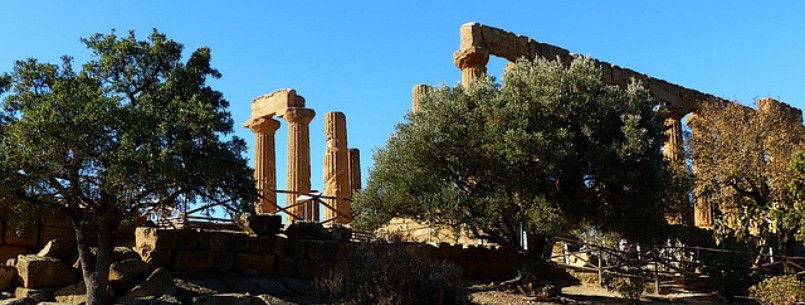
Sicilian Archaeology
Do you know that Sicily and Southern Italy identified as Magna Graecia by the Romans were the new worlds for the ancient Greeks? This is the reason why they built so much in Sicily. They were fighting back home and most of the monuments built in Sicily are still well-preserved.
Sicilian Cities
Palermo has an Arab tone. Siracusa is Greek. Enna, Trapani, Ragusa, Trapani, Agrigento, Messina, Taormina, Erice… All Sicilian cities and towns have a wonderful story behind and beautiful sightseeing to enjoy.
Events in Sicily
Summer is the season with countless events in Sicily: feasts in virtually every town, fireworks, festivals, outdoor concerts… What’s not to like about it?
For beer drinkers and not, this is the event to go. Si Birra is the beer festival in Modica that gathers thousands of people. The idea is to recreate the Oktoberfest with a local approach with Sicilian food delicacies that go with the beer.
The Marrazano World Festival in Catania is a biannual event that celebrates this Sicilian musical instrument of the marrazano as a metaphor of the island. The marazzano is an ancient instrument played around the world.
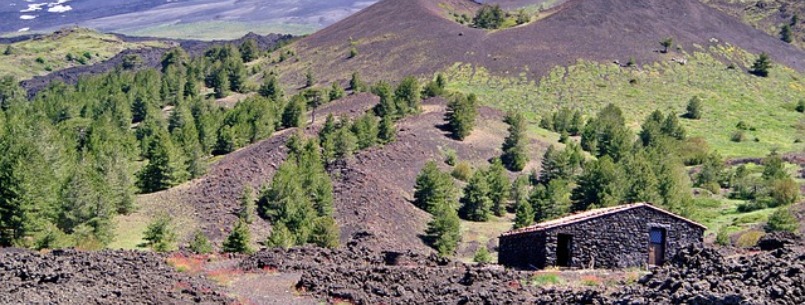
Mount Etna
Mount Etna is spectacular these days. Looking at one of its eruptions is a treat! Follow your guide’s advice if you try to be adventurous here. Mount Etna is one of the most active volcanoes in the world and is in an almost constant state of eruption. Although it can occasionally be very destructive, it is not generally regarded as being particularly dangerous, and thousands of people live on its slopes and in the surrounding areas. The fertile volcanic soils support extensive agriculture, with vineyards and orchards spread across the lower slopes of the mountain and the broad Plain of Catania to the south.
Baroque Architecture in Sicily
The Sicilian baroque is unique. The eight towns in southeast Sicily, Caltagirone, Militello Val di Catania, Catania, Modica, Noto, Palazzolo, Ragusa, and Scicli are Unesco World Heritage.
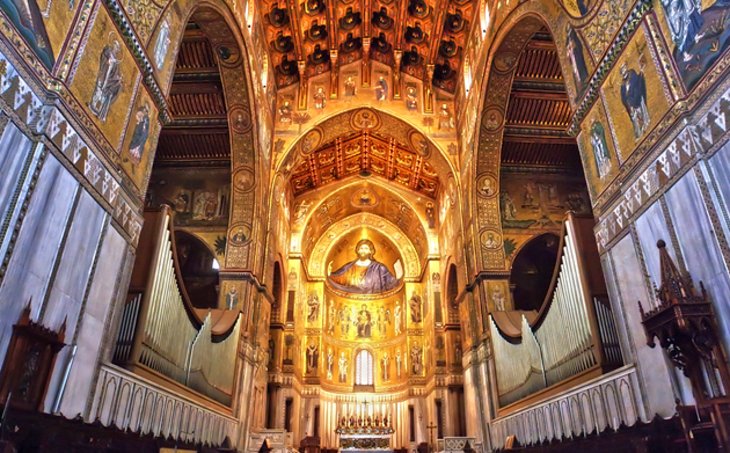
Monreale Cathedral is the greatest of all the monuments to the wealth and artistic taste of the Norman kings in northern Sicily. Founded around 1170 by William II, and dedicated to the Assumption of the Virgin Mary, the church was elevated to the rank of a metropolitan cathedral in 1182. The outside of the Arab-Norman cathedral is plain, except the aisle walls and three eastern apses, which are decorated with intersecting pointed arches and other ornaments inlaid in marble. The archiepiscopal palace and monastic buildings on the south side were of great size and magnificence and were surrounded by a massive precinct wall, crowned at intervals by twelve towers. This has been mostly rebuilt, but little now remains except ruins of some of the towers, a great part of the monks’ dormitory and frater, and the splendid cloister, completed about 1200.
The Palatine Chapel is the royal chapel of the Norman kings of Sicily situated on the ground floor at the center of the Palazzo Reale in Palermo. The chapel was commissioned by Roger II of Sicily in 1132. It took eight years to build and many more to decorate with mosaics and fine art. The sanctuary, dedicated to Saint Peter, is reminiscent of a domed basilica. It has three apses, as is usual in Byzantine architecture, with six-pointed arches (three on each side of the central nave) resting on recycled classical columns.
Authenticity of Sicily
Sicily might have its own problems. However, if you are looking for a great and authentic travel experience, it is a perfect choice. Sicily never pretends to be something else. It is what it is with its centuries of history and foreign invasions. Most past events have brought pain to the island, but also cultural enrichment and unparalleled heritage.
I shared mine, what is your reason #1 to visit Sicily?
